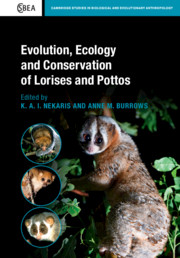Book contents
- Evolution, Ecology and Conservation of Lorises and Pottos
- Cambridge Studies in Biological and Evolutionary Anthropology
- Evolution, Ecology and Conservation of Lorises and Pottos
- Copyright page
- Dedication
- Contents
- Contributors
- Foreword
- Acknowledgements
- 1 Introduction
- Part I Evolution, Morphology and the Fossil Record
- 2 Sluggards and Drunkards?
- 3 What We Know (and Don’t Know) About the Fossil Records of Lorisids
- 4 Outliers
- 5 Molecular Advances in Lorisid Taxonomy and Phylogeny
- 6 The Toothcomb of Karanisia clarki
- 7 The Soft-Tissue Anatomy of the Highly Derived Hand of Perodicticus Relative to the More Generalised Nycticebus
- 8 Making Scents of Olfactory Sensitivity in Lorises and Pottos
- 9 Allometric and Phylogenetic Diversity in Lorisiform Orbit Orientation
- 10 The Evolution of Social Organisation in Lorisiformes
- 11 Biomechanics of Loris Locomotion
- 12 What Role Did Gum-Feeding Play in the Evolution of the Lorises?
- Part II Ecology and Captive Management
- Part III Research, Trade and Conservation
- References
- Index
5 - Molecular Advances in Lorisid Taxonomy and Phylogeny
from Part I - Evolution, Morphology and the Fossil Record
Published online by Cambridge University Press: 29 February 2020
- Evolution, Ecology and Conservation of Lorises and Pottos
- Cambridge Studies in Biological and Evolutionary Anthropology
- Evolution, Ecology and Conservation of Lorises and Pottos
- Copyright page
- Dedication
- Contents
- Contributors
- Foreword
- Acknowledgements
- 1 Introduction
- Part I Evolution, Morphology and the Fossil Record
- 2 Sluggards and Drunkards?
- 3 What We Know (and Don’t Know) About the Fossil Records of Lorisids
- 4 Outliers
- 5 Molecular Advances in Lorisid Taxonomy and Phylogeny
- 6 The Toothcomb of Karanisia clarki
- 7 The Soft-Tissue Anatomy of the Highly Derived Hand of Perodicticus Relative to the More Generalised Nycticebus
- 8 Making Scents of Olfactory Sensitivity in Lorises and Pottos
- 9 Allometric and Phylogenetic Diversity in Lorisiform Orbit Orientation
- 10 The Evolution of Social Organisation in Lorisiformes
- 11 Biomechanics of Loris Locomotion
- 12 What Role Did Gum-Feeding Play in the Evolution of the Lorises?
- Part II Ecology and Captive Management
- Part III Research, Trade and Conservation
- References
- Index
Summary
Lorises (family Lorisidae) are primates of the suborder Strepsirrhini. They belong to the infraorder Lorisiformes, together with their sister group, the Galagidae – galagos from sub-Saharan Africa. The systematics of the family Lorisidae have been long debated. Currently two subfamilies are recognised: Perodicticinae, including the two African genera Arctocebus (angwantibos) and Perodicticus (pottos), and Lorisinae, including the two Asian genera Loris (slender lorises) and Nycticebus (slow lorises) (Mittermeier et al., 2013; Rasmussen and Nekaris, 1998; Rowe and Myers, 2016) (1971) based on a series of craniodental features, and, more recently, supported by a cladistic analysis by Rasmussen and Nekaris (1998). Simpson (1967), however, identified several similarities between the two robust forms, Nycticebus and Perodicticus, and the two small-bodied, slender forms, Loris and Arctocebus. A cladistic analysis on craniodental data by Schwartz and Tattersall (1985) supported these two reciprocal monophyletic clades, but other morphological studies failed to identify a clade including both Perodicticus and Nycticebus (Masters and Brothers, 2002). To further complicate the taxonomy of this primate group, karyological studies conducted in the 1970s identified two alternative groups based on the number of chromosomes: Perodicticus and Loris share a diploid number of 2n = 62, while Arctocebus and Nycticebus exhibit a diploid number of 2n = 52 (although some populations of Nycticebus have 2n = 50) (de Boer, 1973; Masters et al., 2005).
Information
- Type
- Chapter
- Information
- Publisher: Cambridge University PressPrint publication year: 2020
Accessibility standard: Unknown
Why this information is here
This section outlines the accessibility features of this content - including support for screen readers, full keyboard navigation and high-contrast display options. This may not be relevant for you.Accessibility Information
- 5
- Cited by
